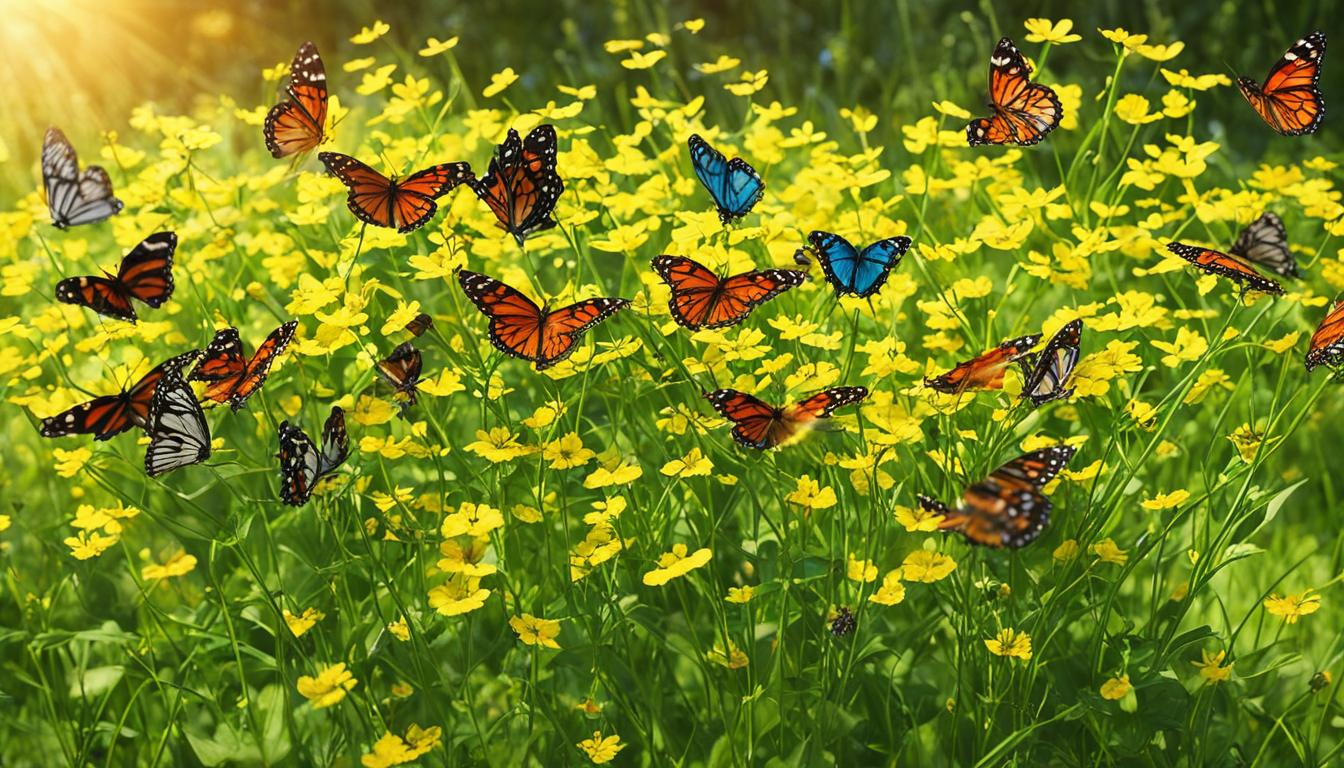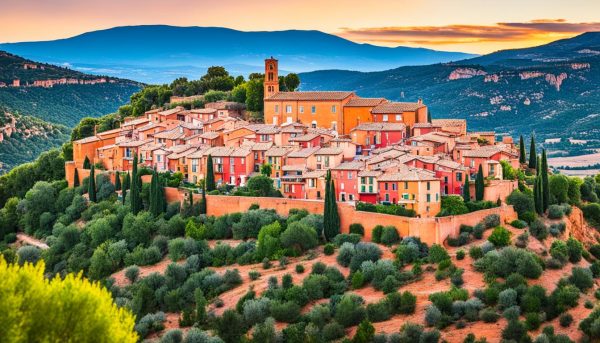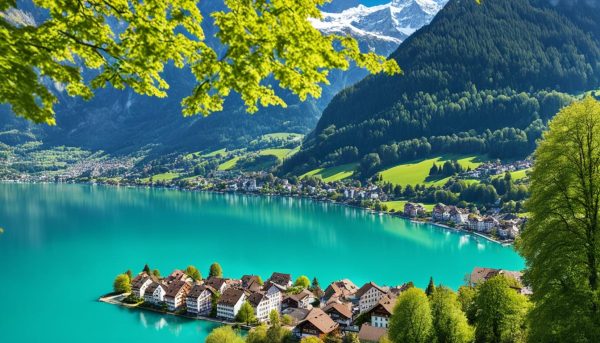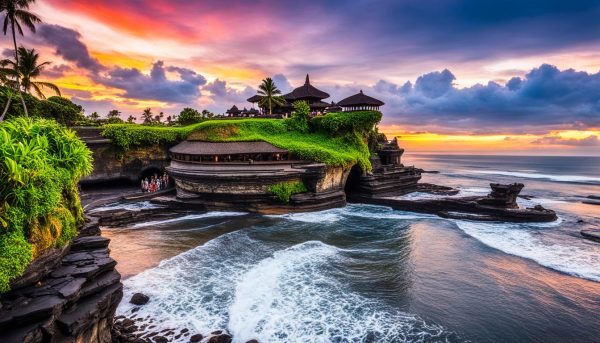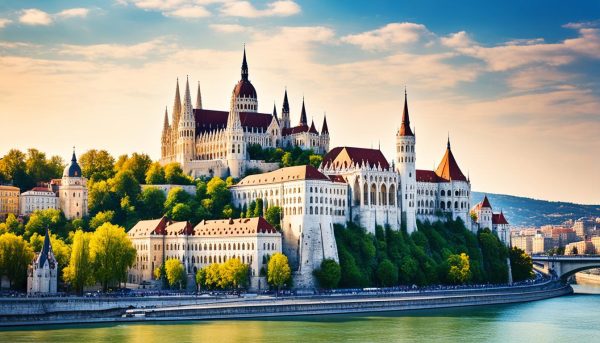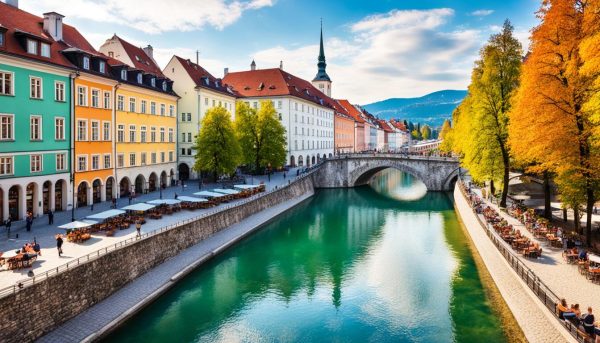Welcome to the captivating world of butterflies! With their vibrant colors, delicate wings, and graceful flight, butterflies have long fascinated both nature enthusiasts and photographers alike. In this comprehensive guide, we will delve into the mesmerizing realm of butterflies and provide valuable tips for photographers who aim to capture their beauty through their lenses. So, grab your camera and get ready to embark on a remarkable journey into the enchanting world of butterflies!
Key Takeaways:
- There are 17,500 species of butterflies worldwide, with nearly 750 species found in the United States.
- Climate change, habitat destruction, and human collectors pose significant threats to butterfly populations.
- Rare and endangered butterflies need our protection and conservation efforts.
- Understanding butterfly habitats and behavior will enhance your ability to capture stunning photographs.
- Preserving butterfly habitats is vital for the survival of these beautiful creatures.
Rare and Endangered Butterflies Around the World
There are several rare and endangered butterfly species around the world that are worth preserving. These delicate creatures, with their vibrant colors and intricate patterns, play a vital role in our ecosystems.
One such species is the Lange’s Metalmark butterfly, which is on the brink of extinction. With only a few hundred individuals left in the wild, this butterfly can be found in the sandy areas along the Sacramento River in California. Its precarious situation serves as a stark reminder of the urgent need for conservation efforts.
The Luzon peacock swallowtail is another butterfly species that is highly endangered. Native to the Philippines, this beautiful butterfly faces threats due to its limited habitat and human activities. Its vibrant colors and graceful flight make it a species worth protecting.
Another remarkable butterfly species facing extinction is the Queen Alexandra’s Birdwing. As the largest butterfly in the world, it is a true marvel of nature. Unfortunately, habitat destruction in Papua New Guinea has driven this majestic creature to the endangered list. The survival of the Queen Alexandra’s Birdwing serves as a testament to the fragility of our planet’s ecosystems.
These rare and endangered butterflies are just a glimpse into the global crisis affecting butterfly species worldwide. Their dwindling populations serve as a wake-up call to the urgent need for conservation efforts. By taking action now, we can ensure the survival and beauty of these mesmerizing creatures for future generations to admire.
Rare Butterflies in the United States
The United States is home to several rare butterfly species that are in need of conservation efforts. These delicate and beautiful creatures face challenges such as habitat loss and pesticide use. Let’s take a closer look at some of the rare butterflies found in different regions of the United States:
Schaus’ Swallowtail
The Schaus’ swallowtail is an extremely endangered butterfly species found in Florida. This magnificent butterfly has faced severe habitat loss due to coastal development, and its population has also been affected by the use of pesticides. With its distinctive black and yellow markings, the Schaus’ swallowtail serves as a reminder of the importance of preserving natural habitats.
Miami Blue Butterfly
After being nearly extinct following a hurricane in 1992, the Miami blue butterfly now exists in small numbers and can only be found in the Marquesas Keys in Florida. This rare butterfly depends on specific host plants for its survival, and protecting its habitat from further destruction is crucial for the species’ survival.
Saint Francis’ Satyr
The Saint Francis’ satyr, once found in regions of North Carolina, is now listed as an endangered species. This small butterfly with intricate patterns can only be found at the Fort Bragg Endangered Species Branch. Efforts to protect and restore its habitat are essential to ensure the survival of this rare butterfly.
Conservation efforts aimed at protecting these rare butterflies are of utmost importance. By preserving their habitats and raising awareness about their plight, we can contribute to the preservation of these beautiful creatures for future generations.
| Butterfly Species | Location | Conservation Status |
|---|---|---|
| Schaus’ Swallowtail | Florida | Extremely Endangered |
| Miami Blue Butterfly | Marquesas Keys, Florida | Endangered |
| Saint Francis’ Satyr | Fort Bragg Endangered Species Branch, North Carolina | Endangered |
The Beauty of Butterfly Habitats
Butterflies depend on specific habitats for their survival. These habitats provide them with food sources, shelter, and the necessary conditions for reproduction. Unfortunately, many butterfly species are facing habitat loss and degradation due to human activities, posing a significant threat to their survival.
One such example is the blue morpho, a stunning butterfly native to the tropical areas of Latin America. Known for its vibrant blue wings, the blue morpho relies on rainforests as its habitat. However, deforestation and the conversion of rainforests into agricultural land and urban areas have led to a decline in their population. As their habitat diminishes, so does the population of this magnificent species, emphasizing the need for conservation efforts.
“The beauty of butterfly habitats lies in their delicate balance of nature. They provide a sanctuary for these enchanting creatures to thrive and play their crucial role in the ecosystem,” says Dr. Emily Carter, a renowned entomologist and conservationist.
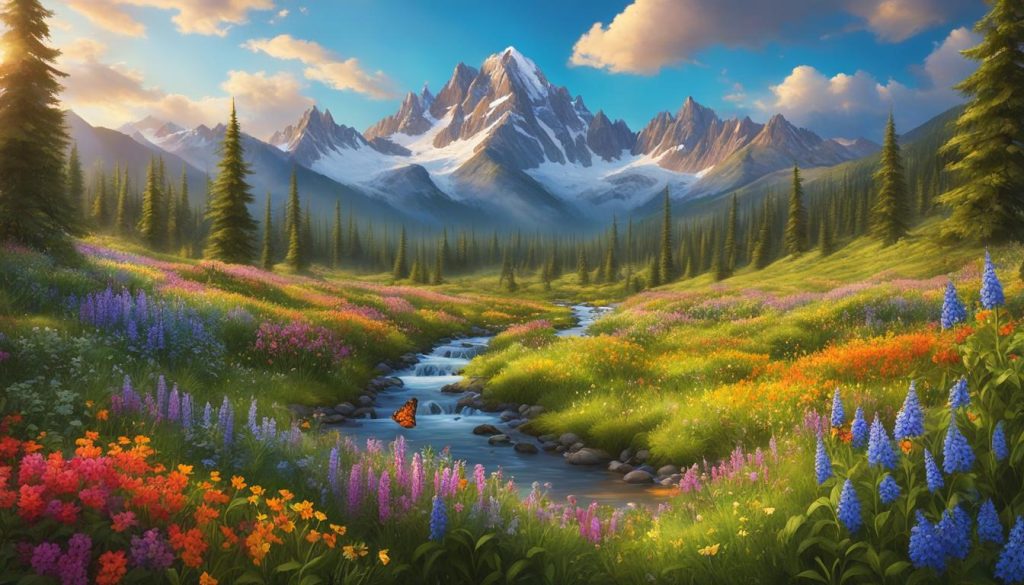
Another butterfly species impacted by habitat loss is the Zebra longwing butterfly. With its distinctive black and yellow-striped wings, this butterfly has an unusually large range across South and Central America. However, human activities such as deforestation, urbanization, and the use of pesticides threaten their habitat and disrupt their natural lifecycle.
To protect and preserve these beautiful creatures, it is crucial to focus on butterfly habitat conservation. By safeguarding natural habitats, we can ensure the continued existence of butterflies and their important contributions to pollination and ecosystem balance.
Conservation Strategies for Butterfly Habitats
Conserving butterfly habitats requires a multi-faceted approach involving individuals, communities, and government organizations. Here are some key strategies for effective habitat conservation:
- Preserving and restoring natural habitats: Protecting existing butterfly habitats and restoring degraded areas can create safe havens for butterflies to thrive.
- Planting native butterfly-friendly plants: Supporting pollinator-friendly gardening practices by planting native flowers and providing suitable food sources for butterflies.
- Reducing pesticide use: Minimizing the use of harmful pesticides and adopting alternative pest control methods that are safe for butterflies and other pollinators.
- Conservation education and awareness: Educating communities and raising awareness about the importance of butterfly habitats and the threats they face can inspire action and promote conservation efforts.
Through collective efforts and a commitment to protecting butterfly habitats, we can ensure the preservation of these delicate and mesmerizing creatures for generations to come.
A Photographer’s Perspective on Butterfly Photography
When it comes to capturing the ethereal beauty of butterflies, a photographer’s eye is essential. Butterfly photography requires not only technical skill but also patience and an understanding of their behavior and preferred habitats.
To capture the intricate details of butterflies, it’s important to use the right equipment. Macro lenses are ideal for getting up close and personal, revealing the delicate patterns and textures of their wings. Telephoto lenses, on the other hand, allow you to capture these enchanting creatures from a distance without disturbing their natural environment.
Understanding the behavior of butterflies can greatly enhance your chances of capturing stunning photographs. Knowing when and where they are most active can help you plan your shoots for optimal conditions. Spending time observing their movements and preferred feeding areas can lead to unique photo opportunities.
Techniques such as capturing in-flight shots can add a dynamic element to your butterfly photography. This requires a fast shutter speed and quick reflexes to freeze their movements mid-flight. Focusing on specific details, such as the intricate patterns on their wings or their delicate antennae, can also add depth and interest to your photographs.
Remember, patience is key in butterfly photography. These delicate creatures can be elusive and easily startled. Take your time, observe their behavior, and wait for that perfect moment to press the shutter button.
“Butterfly photography is a dance between patience and artistry. It’s about capturing the fleeting beauty of these exquisite creatures and sharing their enchantment with the world.” – [Insert Name], Professional Nature Photographer
By honing your skills, understanding the intricacies of butterfly behavior, and using the right equipment, you can create stunning photographs that showcase the magical world of butterflies. So grab your camera, venture into nature, and let these captivating creatures inspire your next photographic masterpiece.
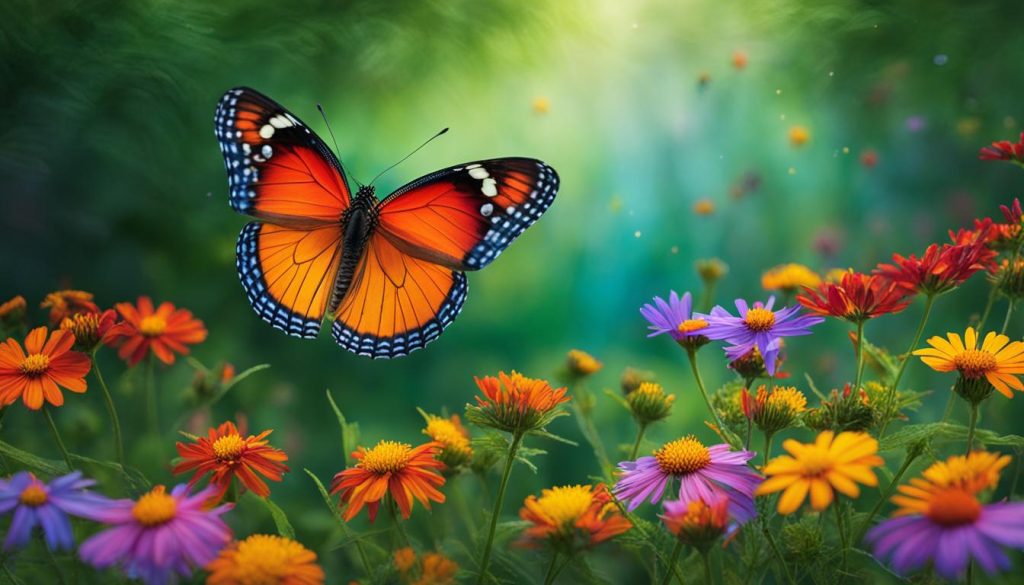
| Essential Equipment for Butterfly Photography | Techniques for Capturing Stunning Butterfly Photographs | Tips for Photographing Butterflies in their Natural Habitat |
|---|---|---|
|
|
|
The World’s Most Captivating Trees: A Photographer’s Journey
Photographer Beth Moon takes us on a captivating journey through her lens, documenting some of the rarest and most awe-inspiring trees in the world. Her passion for these magnificent specimens is evident in her captivating series, showcasing the beauty and vulnerability of these remarkable treasures.
In her series “Ancient Trees,” Moon captures the essence of baobabs, sequoias, and other rare tree species in black and white, allowing us to see their intricate details and textures as if we are beholding these giants in person. The monochromatic palette adds a timeless quality to the photographs, emphasizing the age and wisdom these ancient trees possess.
Beth Moon’s project “Island of the Dragon’s Blood” transports us to the remote and untouched island of Socotra, home to the extraordinary dragon’s blood trees. These unique specimens, with their umbrella-shaped canopies and peculiar red resin, create a surreal and otherworldly landscape. Moon’s photographs capture the mystique and isolation of this breathtaking location.
In her series “Diamond Nights,” Moon combines her expertise in astrophotography with her passion for rare trees. Against a backdrop of glittering stars, she photographs these exceptional trees, showcasing their beauty and vulnerability under the vast night sky. This juxtaposition highlights the delicate balance between nature’s wonders and the ever-changing celestial universe.
The Ancient Trees Documented by Beth Moon
| Tree Species | Location | Notable Features |
|---|---|---|
| Baobab | Africa, Australia, and Madagascar | Gigantic size, distinctive trunk shape |
| Sequoia | California, United States | Tall and ancient, towering presence |
| Dragon’s Blood Tree | Socotra Island, Yemen | Umbrella-shaped canopies, red resin |
| Bristlecone Pine | California, United States | Oldest living trees, twisted and weathered |
Beth Moon’s photography is a testament to the extraordinary beauty and value of these rare trees. Through her lens, we gain a deeper appreciation for these majestic beings and the importance of preserving their habitats. Her stunning images serve as a reminder to cherish and protect the irreplaceable wonders of our natural world.
The Butterfly Wonderland Foundation: Educate, Conserve, and Care
The Butterfly Wonderland Foundation is a non-profit organization dedicated to the education, conservation, and care of butterflies and their habitats. With a mission to protect these beautiful creatures and preserve their fragile ecosystems, the foundation works tirelessly to make a positive impact in butterfly conservation.
Through their core initiatives, the Butterfly Wonderland Foundation aims to create a future where butterflies thrive and inspire generations to appreciate the wonders of nature. Let’s take a closer look at their key areas of focus:
- Education: The foundation believes in the power of education to create lasting change. They provide access to underserved students through field trips, fostering a love for butterflies, and nurturing a sense of environmental responsibility.
- Conservation: By supporting local and global conservation programs, the Butterfly Wonderland Foundation plays a vital role in safeguarding butterfly habitats. Their efforts help ensure that these delicate ecosystems receive the protection they need to sustain diverse populations of butterflies.
- Care: The foundation’s commitment to care extends beyond butterflies to the communities they impact. Through outreach programs and opportunities, they foster a community of care, inspiring individuals to take part in butterfly conservation and make a positive difference in the world.
The Butterfly Wonderland Foundation relies on the support of generous contributions and donations to continue their important work. With each contribution, they can expand their reach, further their conservation efforts, and create a brighter future for butterflies.
Join the Butterfly Wonderland Foundation in their mission to educate, conserve, and care for these enchanting creatures and their habitats.
Testimonial:
“The Butterfly Wonderland Foundation has not only opened my eyes to the world of butterflies but has also provided me with the knowledge and resources to make a difference. Their commitment to education, conservation, and care is truly inspiring!”
– Emily Thompson, Nature Enthusiast
Conclusion
Butterflies are not only beautiful creatures, but they also play a vital role as indicators of the health of our ecosystems. By understanding their habitats and taking steps to protect their environments, we can contribute to the preservation of these delicate creatures for future generations to enjoy.
Photographers have a unique opportunity to capture the exquisite beauty and intricacy of butterflies through their lenses. Through their art, they can raise awareness about the conservation needs of these creatures and inspire others to appreciate and protect them.
Education, conservation efforts, and community care are essential in preserving the majestic world of butterflies. By supporting organizations like the Butterfly Wonderland Foundation and participating in local initiatives, we can make a difference in safeguarding butterfly habitats and ensuring their survival. Together, we can maintain the delicate balance of our ecosystems and continue to marvel at the incredible diversity and grace of butterflies.
FAQ
What is the main focus of this photographer’s guide?
This photographer’s guide focuses on exploring the beauty and intricacy of butterflies and provides tips for capturing their majestic world through your lens.
How many butterfly species are there worldwide?
There are 17,500 species of butterflies worldwide.
How many butterfly species are found in the United States?
Nearly 750 species of butterflies are found in the United States.
Why are many butterfly species endangered or vulnerable?
Many butterfly species are endangered or vulnerable due to climate change, habitat destruction, and human collectors.
Can you provide examples of rare and endangered butterfly species?
Yes, some examples include the Lange’s Metalmark butterfly, the Luzon peacock swallowtail, and the Queen Alexandra’s Birdwing.
What rare butterfly species can be found in the United States?
Some rare butterfly species in the United States include the Schaus’ swallowtail, the Miami blue butterfly, and the Saint Francis’ satyr.
Why is it important to preserve butterfly habitats?
Butterflies depend on specific habitats for their survival, and preserving these habitats ensures the continued existence of these beautiful creatures.
What equipment is recommended for photographing butterflies?
Using macro lenses and telephoto lenses can help capture the intricate details of butterflies.
What techniques can enhance butterfly photography?
Understanding butterfly behavior, preferred habitats, and techniques such as capturing in-flight shots or focusing on specific details can add depth and interest to butterfly photography.
Can you provide examples of a photographer’s work focusing on trees?
Yes, photographer Beth Moon has documented the biggest, oldest, and rarest trees in the world, including baobabs, sequoias, and other species, capturing their beauty in black and white.
What is the Butterfly Wonderland Foundation?
The Butterfly Wonderland Foundation is a non-profit organization dedicated to educating, conserving, and caring for butterflies and their habitats.
How does the Butterfly Wonderland Foundation support conservation efforts?
The foundation supports conservation programs at the local and global level and fosters a community of care through outreach programs and opportunities.
Why are butterflies important indicators of ecosystem health?
Butterflies are important indicators of ecosystem health as their presence and abundance can reflect the overall health and balance of ecosystems.
How can photographers contribute to butterfly conservation?
Photographers can play a crucial role in capturing the beauty and intricacy of butterflies, raising awareness about their conservation needs.

